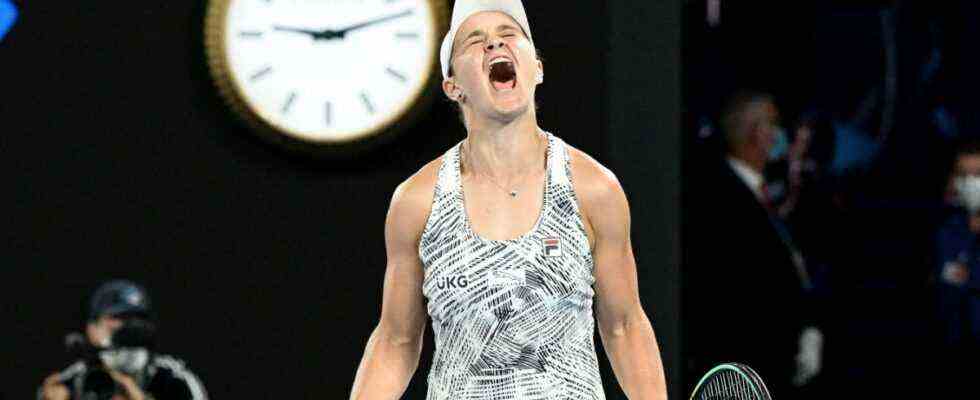Anyone who wanted to understand how Atlas felt when he once had to shoulder the world had only to look in the face of tennis player Ashleigh Barty: second set in the final of the Australian Open, her home tournament, in front of an audience like the entire country expected nothing less than the end of a great title drought and that highly paid quiz question, like the last Australian winner down under was called. Chris O’Neil, who triumphed in 1978 when neither Billie Jean King, nor Martina Navratilova, nor Chris Evert, nor Virginia Wade made the arduous journey to the fifth continent, sat in the audience, obediently wearing a face mask, and watched her compatriot weighed down by expectations stumbled.
Barty walked through the tournament for six and a half games, apparently weightless, her whole game a single smile because she had hit the balls so early, so cleanly and with so many variations. Now that all seemed far away. Because after an almost effortless first set (6:3), the 25-year-old was suddenly 1:5 behind. With a series of unusual mistakes, she let her fearless opponent Danielle Collins back into the match. The 28-year-old American hammered the balls into the corners again with her two-handed backhand.
Despite this, there was no unrest in the Barty camp. “I was prepared for a third set,” her coach Craig Tyzzer later said, “but I wasn’t that worried in those minutes, it was just little things and she had lost her touch a bit, which also had to do with that it was cooler than in the other night sessions and the balls were moving more slowly”, which benefited Collins. “But Ash likes a challenge, so I wasn’t nervous.”
Barty shows the most amazing part of her talent when things get tight
As if this calmness had spread to his player, the Australian quickly got back on track. “I let Danielle take the initiative too much and just wanted to try to swing looser and play more aggressively again,” Barty said later, and the better she did that, the more she took the initiative back, the more her opponent had to retreat and play further behind the baseline, a zone that suits her less. Re-break to 2:5, 3:5, re-break to 4:5, and then, when it threatened to get tight again at 5:6 and 15:30, the woman from Ipswich showed, close to the Australian gold Coast in western Australia, once again the most amazing aspect of her talent: Barty, who was just 1.66 meters tall, slammed three service winners over 170 km/h into Collins’ field. 6:6 and a tie-break, but with a clear psychological advantage for Barty. “She showed me what I still need to improve on,” said Collins, who was used to being determined on the pitch but fair in defeat, “above all, she played her best tennis in the crucial moments. And I still have to learn that .”
Less than ten minutes after the 6: 6, the 6: 3, 7: 6 (2) success was perfect, which Barty celebrated with an emotional outburst that no one has allegedly seen from the well-tempered Australian. Shortly afterwards Evonne Goolagong-Cawley, one of Barty’s idols, emerged from her hiding place, not watching the match on the pitch so as not to increase the pressure on her compatriot. Now perhaps the most elegant player of the 20th century could present the trophy to the winner of the evening and the most elegant player of the day. “I thought she couldn’t come,” Barty said of the successful surprise. “She’s always helped me throughout my career, so it was even nicer that it was her who gave me the trophy.”
Two icons of Australian sports history: Ashleigh Barty with her idol Evonne Goolagong-Cawley.
(Photo: Paul Zimmer/Imago)
She was showered with praise from all directions. “I’m really happy for her,” said compatriot Thanasi Kokkinakis, who watched large parts of the final in the warm-up zone, “she’s a real role model.” His doubles partner Nick Kyrgios, who wasted so much time in his career but sensationally won the doubles competition that night with his buddy Kokkinakis, said: “We knew early on that a lot was to be expected from her because we saw , how much talent she brought with her and how much heart and soul she put into her career.”
The petite protagonist finally explained that she didn’t feel that much of a burden from the expectations, “I’ve always tried to simplify things and enjoy things – definitely the media will miss this topic more than I do”. She completed her marathon through the belly of the giant facility and the interview zones with a winning smile, initially with a peaked cap on her head and, once the camera light was on, with the Daphne Akhurst Trophy in the hand that punchline-addicted people claim is half the height of Barty himself. Later she walked once more through the corridor, on whose walls are written the names of the legends, Count, Serena, Hingis, Capriati, and posed in the catacombs them with Evonne Goolagong-Cawley and Cathy Freeman: icons of Australian sporting history, which now includes Barty.
She has three titles in her slam collection, even though she ended the season early in 2020 due to Corona and preferred to play golf and cricket at home instead of traveling to New York and Paris. Now, of the four biggest titles, she’s only missing the one from the US Open. What should prevent the first real Grand Slam since Steffi Graf’s coup in 1988 in September of this year? That was the only moment when Barty’s coach Tyzzer’s storytelling darkened. “The tournament in New York is played with balls that are practically impossible to control. If they don’t switch balls there, Ash won’t win this tournament.” But maybe that’s just the kind of challenge Ashleigh Barty needs.

